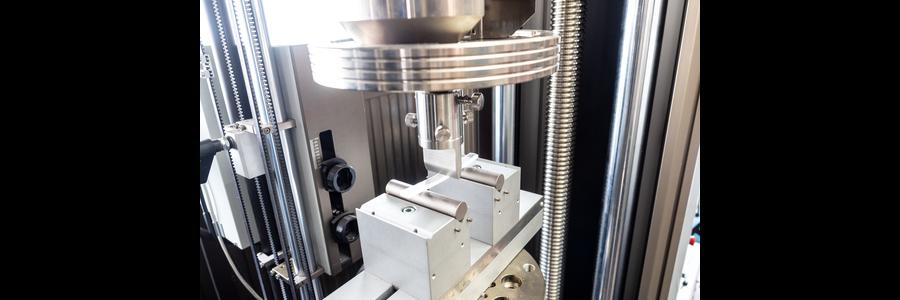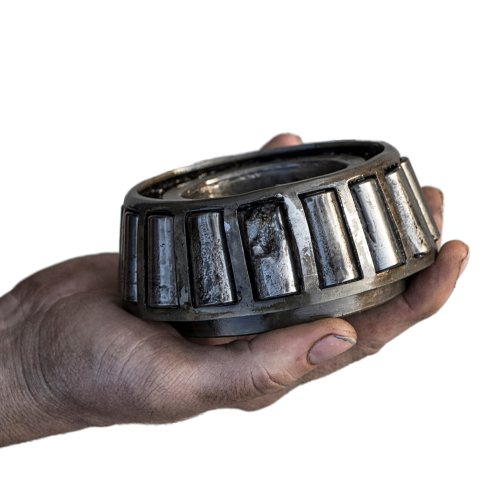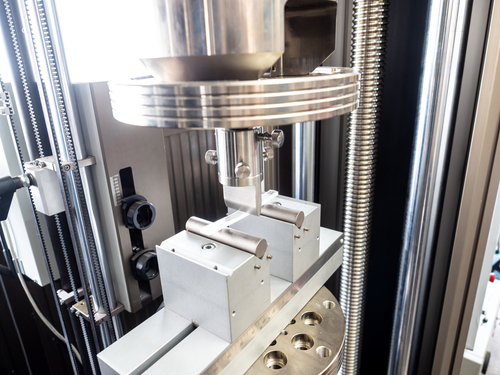Choosing Bearing Materials for Optimal Performance and Lifetime

Introduction
In the field of mechanical engineering, recognition of the need to constrain relative motion between two parts and reduce the friction generated by that motion is thousands of years old. Early bearings were what we now call “plain bearings” and consisted of a bearing surface and no rolling elements. Today, each kind of bearing has a wide array of engineered materials that can be used to sustain greater speed of relative motion, allow greater loads, and extend the maintenance cycle and lifetime of the bearing. In fact, much of the advancement in bearing performance is due to advances in material science.
There are several high-level criteria such as the speed of the moving part and the size of the bearing load that go into bearing selection, but bearing material is a primary enabling factor that qualifies a bearing for a range of speed and load and determines the expected lifespan of the bearing. Before choosing a bearing material for a particular application, a cursory understanding of friction and the wear mechanisms that are experienced by bearing materials is important.
| Find bearings in e-shop | Online shop |
What Causes Friction and Wear?
In a bearing, two materials are made to either slide over each other or roll over each other with minimal friction and minimal wear of either bearing material. Even highly polished surfaces are not completely smooth and have a quantifiable surface roughness that under a microscope looks like a mountainous terrain with peaks and valleys. The peaks in the surface are referred to as surface asperities, and these can have an RMS value of between 0.01 – 250 µm. Two surfaces that slide over one another are separated by the asperities, and contact occurs at only a few of the spots where the asperities touch. Since the contact area where the surface asperities meet is tiny compared to the nominal contact area, the normal load on the bearing creates a very high compression stress at the contact. This high stress elastically and plastically deforms the asperity at the point of contact, enlarging the contact area. The deformation of the softer of the two materials is predicted by the compression strength, or penetration hardness, of the softer material – we can visualize this contact area as the point of the harder surface aspersion pushing into the softer material. The size of the contact area impacts the friction force between the two materials.
The friction force in between sliding elements is based on the theory of adhesion, a force due to intermolecular forces that arise between two materials when they are squeezed together. The contact areas described above adhere together through intermolecular bonds, the size of these junctions is between 10 and 50 µm. The tangential friction force is the sum of the external forces required to break these junctions and is proportional to the microscopic contact areas as described above which in turn is proportional to the normal force. This is why the simplest treatment of friction – the Colomb friction law – has the friction force proportional to the normal force. Since the normal force deforms the surface asperities into finite contact areas that molecularly bond with the mating bearing material, the greater the normal force, the greater the bond area and therefore greater friction force. When the normal force is relaxed, the contact areas of the asperities reduce to point contact and friction disappears.
The breaking and reforming of these junctions as the two parts slide over each other causes the conversion of kinetic energy to heat energy. The surface asperities of the softer material may also break and cause some bearing material transfer to occur between the rubbing materials. For this reason, material compatibility in bearing materials is an important consideration. For use in bearings, two materials are compatible if they form relatively weak molecular bonds with one another. In metals for example, if the two metals have high solubility with each other – readily forming an alloy – then they will not perform well as a bearing since the alloyed metal at the interface will require more force to break than between two metals that have low solubility. This is why it is rare to see identical metals in a plain bearing – since they are completely soluble with one another the friction is high, heat builds up quickly and the bearing will fail. An example of high compatibility is steel on a tin-lead or tin-copper alloy (white or Babbitt metals). These soft alloys are actually a metal matrix composite with hard crystals dispersed in the softer metal, and this configuration allows the surface asperities of the steel to remain undeformed as the bearing force is taken up in the elastic matrix of alloy and the hard crystals provide only small contacts areas for the bearing surface.
Figure 1: When designing a bearing, the choice of material is one of the crucial parts.
Why Bearing Materials Are Important
To achieve the goal of carrying the bearing load with a minimum of friction and wear clearly the choice of bearing material is important. Whether a plain bearing or a bearing with rolling elements, bearing materials experience the following types of wear[1]:
Adhesive Wear: Discussed above, this type of wear comes from the ripping off of the tips of the surface asperities when the molecular bonds between bearing materials are stronger than the shear strength of the bearing material. Sometimes the fractured portion of the tip stays attached to the other materials, or sometimes it releases from both bearing surfaces and becomes a contaminant. In dry bearings, this type of wear can be severe.
Abrasion Wear: Hard particles can find their way onto the bearing surfaces (such as sand, metal debris, or carbon ash) to abrade the surfaces of the bearing. Also, when the bearing material surfaces are rough, the size of the broken surface asperities is large and can cause more abrasion wear than smaller particles would. In well-designed bearings with sufficient lubrication, up to 85% of wear can be due to abrasion. Bearing seals can help reduce abrasion wear, as can the use of a soft bearing material that embeds the abrasive particles thus protecting the bearing surface.
Fatigue Wear: Evidenced by pitting on the bearing surface, fatigue wear most often occurs in the line-contact or point-contact friction found in rolling element bearings or gears. The large, alternating compression stresses in rolling element bearings that occurs when the entire bearing load rests on only a few points of contact cause highly localized areas of stress concentrations that lead to tiny cracks below the surface. These tiny cracks open up and grow as the number of cyclic stress events increase during the life of the bearing. Fatigue cracks can be distinguished into three types. Pitting is triggered by surface defects or roughness, and the presence of micro-notches. Spalling is a condition that includes sub-surface cracks caused the alternating shear stresses near inclusions in the material. Finally, cracks that originate at deep material defects appear in the low-stress zones of the bearing surface.[2]
Corrosion Wear: In the presence of oxidizing substances such as seawater, washdown fluids, and chemicals and coatings that are part of the industrial process where the bearings are employed can all contribute to the surface corrosion on the bearings causing premature failure. Even the lubricants used in the bearings can oxidize over time and become corrosive to the bearing. Particularly in high temperature environments such as internal combustion engines, corrosion wear is an important factor in bearing design.
Figure 2: Tapered roller bearing with obvious wear on rollers.
Relevant Bearing Material Properties
Of course, there are other considerations in bearing design beyond materials and even the best materials will not overcome a poor design in other areas. There is no single ideal material for a bearing and there is a wide range of materials to choose from including metals, plastics, and composite materials. The following list of material properties are a primary focus when designing a bearing.[3]
Score and Seizure Resistance: Discussed above, using compatible metals in plain bearings is important. Along with minimizing the adhesion forces that cause friction, compatible metals reduce scoring and galling that is common when two identical metals slide past one another while being squeezed together.
Embeddability: This important property of soft metals reduces abrasion wear by allowing contaminants found on the shop floor (and even in the bearing lubricants, particularly when oxidized) to be embedded in the soft bearing material and thus kept away from causing abrasion wear.
Corrosion Resistance: Bearings are often used in environments conducive to corrosion such as moist maritime air, high temperatures, and industrial settings with high concentrations of corrosive liquids and gases. Metal alloys such as 316 and 440 grade stainless steel are commonly used in corrosive environments. Full ceramic bearings made from materials such as zirconia, and silicon nitride can be used fully submerged in marine environments. Bearings made of plastics such as PEEK, PTFE, PVDF, and acetal resin with 316 stainless steel or glass balls have very good resistance to corrosion and are used in low load, high chlorine environments such as swimming pool pumps.[4]
Fatigue Resistance: The most used material in high quality rolling bearings is SAE 52100 steel which has a wide temperature range and good fatigue resistance. A more exotic material for the aerospace market where bearing failure must be avoided at all costs is M-50, an alloy containing increased molybdenum that increases fatigue resistance[5].
Figure 3: Testing of bearing material characteristics.
Conformability: Soft alloys such as Babbitt metals (white metals) have high conformability which is the ability to deform plastically or elastically to accommodate misalignment, manufacturing tolerances, and other inaccuracies that improve machine function and bearing life. Plastic bearing surfaces such as Teflon also have high conformability.
Friction Coefficient: Discussed in more detail above, the friction coefficient is affected by the lubrication strategy as well as temperature and speed. Often, a combination of hard and soft materials is desirable.
Porosity: There are several sintered bearing materials that have high porosity. These pores trap lubricants through capillary action and therefore stay lubricated for the life of the bearing. Often sintered bronze, these plain bearings for low speeds can offer significant advantage through reduction of maintenance costs.
Thermal Conductivity: Since heat builds up in any bearing due to the frictional forces, a relatively high thermal conductivity is desirable to allow this heat to dissipate from the bearing surface. Managing the temperature of the bearing surfaces is desirable for long life bearings.
Thermal Expansion: The thermal expansion of the bearing material impacts bearing function and life, and the clearances between the sliding or rolling surfaces must be designed to accommodate the thermal expansion, or the bearing could seize when the thermal expansion increases the force on the sliding or rolling surfaces.
Compressive Strength: For most applications where the bearing loads are high, a high compressive strength is needed by the bearings to carry this load. This property conflicts with the properties of embeddability and conformability, so the designer has to choose which property is most desirable for a particular application and accommodate in some other way for the other.
Cost: Cost (both acquisition and lifecycle) and complexity are factors that drive all engineering decisions. Bearings made from bronze and plastics tend to be the lowest cost bearings, while expensive alloys are justified for use in aerospace applications by the high cost of failure.
| Advance search of bearings in the e-shop | Online shop |
Common Bearing Materials
With an understanding of the physical properties of suitable bearing materials, the table below lists some common bearing materials, their desirable attributes and the inevitable tradeoffs that justify the high salary paid to engineers who weigh both in the balance. Whether it's for industrial machinery, automotive applications, or even household appliances, selecting the right bearing material is essential for maintaining smooth operation and minimizing maintenance requirements.
|
Bearing Material |
Desirable Attributes |
Tradeoffs |
|
Chrome Steel SAE 52100. Case Hardening Steel SAE 4118 |
|
|
|
Stainless Steel AISI 440C |
|
|
|
High Alloy Steel AISI M-50 High Alloy Steel M50NiL |
|
|
|
Stainless Steel DD400 |
|
|
|
Ceramics: Silicon Nitride, Zirconia, Silicon Carbine
Used in hybrid bearing (ceramic balls on steel races) and all-ceramic bearings |
|
Low load capacity High Cost Sensitive to thermal shock[6] |
|
White Metals or Babbitt Metal (tin based alloys with small amounts of copper, antimony, lead, and similar) |
|
|
|
Copper-Lead Alloys |
|
|
|
Bronze |
|
|
|
Aluminum Alloys |
|
|
|
Silver |
|
|
|
Plastics (nylon, acetal, PTFE, phenolic, polyamide, high-density polyethylene, polycarbonate) |
|
|
|
Carbon graphite |
|
|
References:
[1] Avraham Harnoy, Bearing Design in Machinery: Engineering Tribology and Lubrication (New York: Marcel Dekker, 2002).
[2] P. J. Romanowicz, and B. Szybiński, "Fatigue Life Assessment of Rolling Bearings Made from Aisi 52100 Bearing Steel," Materials (Basel) 12, no. 3 (Jan 24 2019), https://dx.doi.org/10.3390/ma12030371.
[3] Harnoy, Bearing Design in Machinery: Engineering Tribology and Lubrication.
[4] smb bearings, "What Are Corrosion-Resistant Bearings," 2023, accessed 5 December, 2023, https://www.smbbearings.com/what-are-corrosion-resistant-bearings.
[5] Bearing and Gear Steels for Aerospace Applications, by Erwin Zaretsky, Technical Memorandum 102529 (Cleveland: NASA Lewis Research Center, 1990).
[6] Precision BC, "Advantages and Disadvantages of Ceramic Bearings," 2015, accessed 5 Dec, 2023, https://www.bcprecision.com/blogs/news/71278725-advantages-and-disadvantages-of-ceramic-bearings.



























Leave a Comment
Your email address will not be published. Required fields are marked *